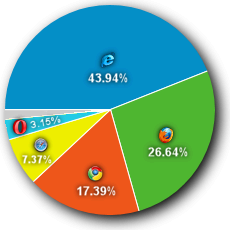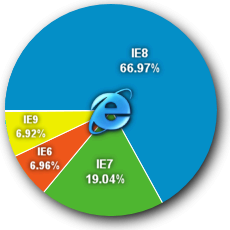 So, no sooner do we blog about the Release of Firefox 6, and go on to outline how we also test our online scheduling tool in the very latest “alpha” builds of Firefox 8.0 too.. Mozilla go and bump the “alpha” build version from 8.0 to 9.0 overnight!!
So, no sooner do we blog about the Release of Firefox 6, and go on to outline how we also test our online scheduling tool in the very latest “alpha” builds of Firefox 8.0 too.. Mozilla go and bump the “alpha” build version from 8.0 to 9.0 overnight!!
So we decided to look a little closer at just what’s going on with Mozilla’s rapidly increasing “versioning” of Firefox of late…
In its simplest form, a browser version is made up of two numbers separated by a decimal point (period). The first number would be the “Major” version number, representing a significant milestone release. The second number would be the “Minor” version number, reflecting subsequent “minor” changes since the “Major” version was released. Sometimes a “revision” number or “build date” was also tagged onto the end of the version string.
Back in the days when there was really only two main players in the browser market, Microsoft Internet Explorer and Mozilla Firefox, browser versions incremented steadily and logically. For Internet Explorer, the release of significant versions went a little something like this:
IE1.0, IE2.0, IE3.0, IE4.0, IE5.0, IE5.5, IE6.0, IE6.1, IE7.0, IE8.0, IE9.0
..with IE10.0 expected to be ready to coincide with the release of Windows 8 next year
Firefox followed in a similar vain for their significant releases:
FF1.0, FF1.5, FF2.0, FF3.0, FF3.5…
But then something happened to shake up the Browser world… along came Google Chrome!
Starting with version “1.0”, Chrome’s developers decided to do away with traditional versioning of each minor update. Instead, they decided that EVERY update they released for Chrome would be a “major milestone”! Hence, why after just a year or two in development, Google Chrome has already jumped up to version 12.0 (with “alpha” builds available right now for version 15.0!)
For most people comparing two similar software products, “Version 12” of one browser sounds more impressive and stable than “Version 3” of another web browser. So, not wanting to be outdone, Mozilla has now followed suite and instead of releasing logical progressions of Firefox 3.6, 3.7, 3.8…etc, they’ve jumped from 3.6 to 4 to 5 to 6 in a matter of months!!
To make matter’s worse, Mozilla could well be doing away with visible version numbers altogether in the not too distant future! Explaining the reasoning, Mozilla’s Asa Dotzler wrote in a discussion forum:
” We concluded that most people don’t need to know what version number they’re using and what they actually want to know is whether or not they’re running the latest version. For the few people who care whether it’s version 7 or version 2011-08-16 or version 1.8.0.0.1.77, they can get this information from about:troubleshooting which is available in the Firefox Help menu.”
Dotzler added:
“We have a goal to make version numbers irrelevant to our consumer audience.”
So what can we learn from all this?
A software version number these days carries very little merit!
A higher version number of one product no longer means any more development has gone into it than a similar product with a lower version number!
Whilst these version numbers may well be irrelevant to a “consumer audience” as Mozilla state, they do still provide essential information to developers who create web-based apps such as ourselves!
If ever a user experiences difficulty with our software, one of the first things we ask them is which browser and version they are using! Making it more difficult for a non-technical user to locate this information isn’t going to be helpful!
Where will it end!?
Well, unless rival web browser developers stop competing for “version number supremacy”, who knows! …maybe it won’t be long until we see Firefox v53 and Google Chrome v182!!
Right now, Microsoft and Apple seem to be the only ones still maintaining some degree of sanity in the versioning of their respective browsers, Internet Explorer and Safari.
You can see which browser versions our web based scheduling software supports here
We have no plans on changing the way we “version” each new release of our browser based room scheduling software – you’re not suddenly going to see “MIDAS v12”!!
We keep our versioning really simple and straight forward. For example, our last releases of MIDAS were 3.10, 3.11, 3.12, 3.13, and our next will almost certainly be 3.14! (Unless we decide to code name it “Pi”! hehe!)
 The Google Chrome team have today announced the release of Chrome 19 for Windows, Mac and Linux operating systems.
The Google Chrome team have today announced the release of Chrome 19 for Windows, Mac and Linux operating systems. So, no sooner do we blog about the
So, no sooner do we blog about the 

 Internet Explorer 6 was first released back in August 2001 just a year after the release of IE5.5. Since IE6’s release, Microsoft have subsequently released 3 major versions of their Internet Explorer software. IE7 was released in October 2006, IE8 in June 2009, and this year saw the release of Internet Explorer 9, with IE10 already well in development. But there was a long gap between the release of IE6 and IE7 (5 years in fact!). This allowed for widespread adoption of IE6 by IT departments the world over during this period.
Internet Explorer 6 was first released back in August 2001 just a year after the release of IE5.5. Since IE6’s release, Microsoft have subsequently released 3 major versions of their Internet Explorer software. IE7 was released in October 2006, IE8 in June 2009, and this year saw the release of Internet Explorer 9, with IE10 already well in development. But there was a long gap between the release of IE6 and IE7 (5 years in fact!). This allowed for widespread adoption of IE6 by IT departments the world over during this period. Whilst Microsoft do provide some helpful resources for corporate IT departments looking to migrate from IE6, Microsoft have committed to continue support for IE6 until 2014 (coinciding with the “End of Life” of Windows XP), primarily because of this corporate sector! In our opinion, Microsoft should have ended support for IE6 a long time ago. If they had, it would force corporations and developers alike to upgrade and modernize their software. Ultimately, this benefits the wider Internet community! Developers can then utilize new and emerging web technologies, such as HTML5, CSS3. This in turn provides a better user experience, rather than developers having to instead spend time trying to make their modern software backwards compatible with a decade old obsolete browser!
Whilst Microsoft do provide some helpful resources for corporate IT departments looking to migrate from IE6, Microsoft have committed to continue support for IE6 until 2014 (coinciding with the “End of Life” of Windows XP), primarily because of this corporate sector! In our opinion, Microsoft should have ended support for IE6 a long time ago. If they had, it would force corporations and developers alike to upgrade and modernize their software. Ultimately, this benefits the wider Internet community! Developers can then utilize new and emerging web technologies, such as HTML5, CSS3. This in turn provides a better user experience, rather than developers having to instead spend time trying to make their modern software backwards compatible with a decade old obsolete browser!